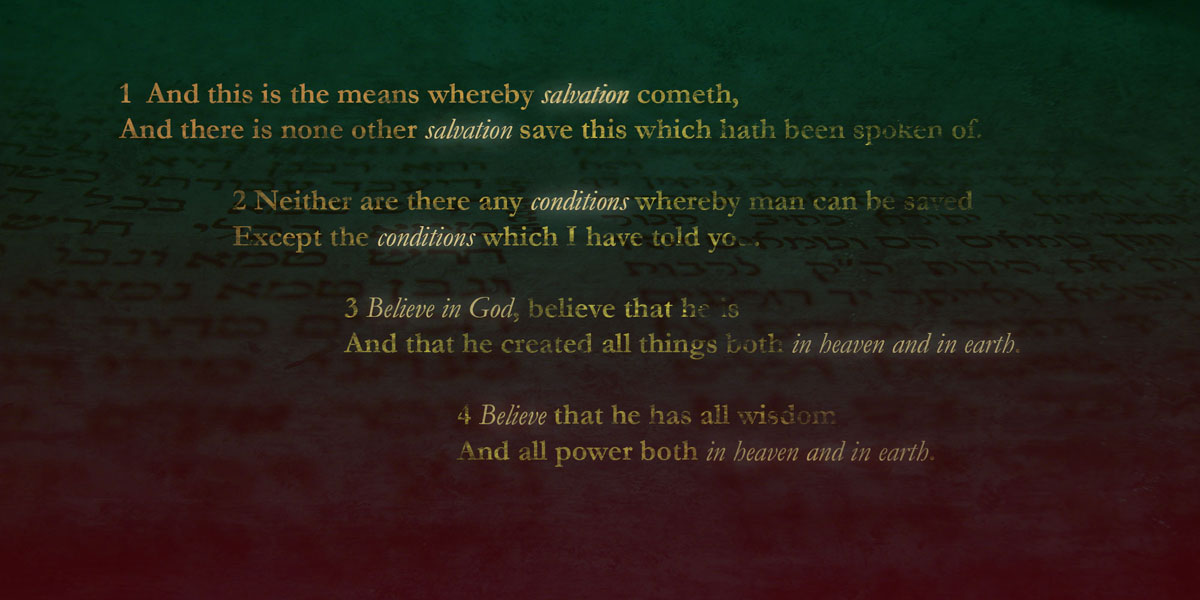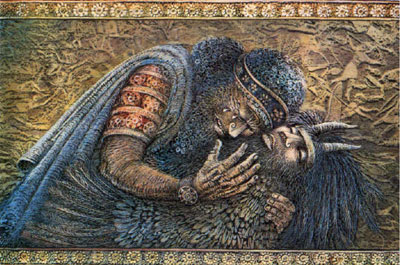
Editor’s Note: This year marks 50 years since the discovery of chiasmus in the Book of Mormon on August 16, 1967. To celebrate this 50th anniversary, throughout July and August Book of Mormon Central will publish one KnoWhy each week that discusses chiasmus and its significance and value to understanding the Bible, the Book of Mormon, and other ancient literatures. Be sure to check out our other KnoWhys on chiasmus and the Chiasmus Resources website for more information.
The Know
The word chiasmus comes from the Greek chiasma, “crossing,” based on chiazo, “to make a mark like the letter X.” A simple example of a chiasm in the Bible is Mark 2:27: “The Sabbath was made for man, and not man for the Sabbath.”
This example from Mark is a very simple chiasm, but there are many occurrences of chiasmus throughout the Bible and in the literature of the broader ancient Near East that vary greatly in their length and complexity. They range from several verses to whole chapters, and even entire books.
BYU Professor John W. Welch has pointed out that scholars “have identified fascinating chiasms in virtually every book of the Bible, whether the poetry of the Psalms or the prose of the Gospels, whether in law, prophecy, or epistolary.”1 Biblical scholar Mitchell Dahood has noted, “On micro and macro levels chiasmus has been shown to be a basic element in the formal structure of biblical literature.”2
Furthermore, these literary structures are not present simply to add variety to the text or show off the ancient authors’ skills, but “to enhance appreciation for a composition’s logic, impact, and beauty; to link form with substance; to clarify conceptual connections or contrasts; and to aid in studies of comparative literature.”3
For example, the central line or thought in most chiasms is the most important idea, with the other supporting ones building up to and then down from the center point (in an A-B-C-B-A pattern, where C represents the central message). Genesis 17, in which God makes a covenant with Abraham, demonstrates this structure, as follows4:
|
A Abram’s age (Genesis 17:1) |
|||||
|
|
B The Lord appears to Abram (v. 1) |
||||
|
|
|
C God’s first speech (vv. 1–2) |
|||
|
|
|
|
D Abram falls on his face (v. 3) |
||
|
|
|
|
|
E God’s second speech (names/kings/nations) (vv. 4–8) |
|
|
|
|
|
|
|
F God’s third/most important speech (covenant) (vv. 9–14) |
|
|
|
|
|
E’ God’s fourth speech (names/kings/nations) (vv. 15–16) |
|
|
|
|
|
D’ Abraham falls on his face (vv. 17–18) |
||
|
|
|
C’ God’s fifth speech (vv. 19–21) |
|||
|
|
B’ The Lord goes up from Abraham (vv. 22–23) |
||||
|
A’ Abraham’s age (vv. 24–25) |
|||||
When the center point of the chiasm is identified, readers can better understand which ideas the author wanted to emphasize strongest. This is especially helpful for identifying the key message of entire books, such as the biblical books of Ruth, Amos, Mark, John, Hebrews, and Revelation, where book-long chiasms have been identified.5
Although numerous scholars, for nearly two centuries, have persuasively argued for the existence of chiastic structures throughout the Bible, some biblical scholars found themselves skeptical of the prevalence or significance of these arrangements, especially in earlier eras. Some critics argued that many of the proposed chiasms are unconvincing, meaningless, or have often been forced to fit an artificial structure not intended by the original authors.
The ancient near eastern Epic of Gilgamesh contained examples of chiasmus. Painting of Gilgamesh and Enkidu. Artist unknown.
In order to address such legitimate concerns, several scholars have worked independently to create rules and standards for identifying chiasms.6 Welch has noted that although evidence of chiasmus is subject to some subjectivity, “a phenomenon as widespread as chiasmus over the entire span of biblical literature warrants some presumption of ancient awareness and conscious reception.”7
In further support of “ancient awareness” of this literary device, examples of the use of chiasmus have been found throughout the main bodies of literatures from the ancient Near East,8 from as early as the third millennium B.C. in several Sumero-Akkadian and Ugaritic texts, but not discovered and translated until about half a century ago.9 To cite one example, biblical scholar Gary Rendsburg identified a chiasm in the Epic of Gilgamesh that corresponds significantly with the chiasm found in the biblical narrative of Noah and the flood. Rendsburg claimed that the biblical version follows the Akkadian story “point by point and in the same order.”10
Although the Greeks and Romans also used this structure,11 prior to those classical times concentric literary structures were already a staple of the ancient Semitic literature that helped shape the cultural setting of the biblical world.12 Biblical scholar Craig Blomberg pointed to the early and “widespread use of chiasmus in both prose and poetry … throughout the ancient Near East.”13
The Why
As John W. Welch remarked, “There has already been much discussion about this discovery in relation to the Bible, and now it is time that we consider it in relation to the Book of Mormon.”14 Welch went on to reason that if this aspect of Hebrew literature is so apparent in the Bible, “it ought to appear in the Book of Mormon, it being of Hebraic origins.”15
Welch argued that “we have several specific reasons for expecting chiasmus there,” including the fact that “Nephi tells us that he is writing in the language of the Egyptians but ‘according to the learning of the Jews.’ (1 Ne. 1:2).”16 Welch proposed that the appearance of chiasmus in the Book of Mormon strongly suggests both a Hebrew background and an ancient Near Eastern origin for the book. The fact that chiasmus is found so fundamentally and extensively throughout the scribal practices in the world from which Lehi came is consistent with the premise that Book of Mormon authors in fact knew the literary styles of “the Jews” and used them in their own profound and creative ways.
Beyond this, the recognition of chiasmus in the Book of Mormon helps readers better understand the key messages and most important doctrinal points that its authors were wanting to convey. On this point, Professor Welch maintained:
Chiasmus helps us to appreciate the depths that are plumbed and the intricacies that are penetrated by the thoughts of men like Nephi, King Benjamin, and Alma the Younger. It allows us to snatch up in a breath the subtle beauties of their scintillating and inspired verses. Through chiasmus we come a giant step closer to the Spirit of and in the Book of Mormon.17
Further Reading
John W. Welch, ed., Chiasmus in Antiquity: Structure, Analysis, Exegesis (Hildesheim, Germany, 1981; reprint, Provo, UT: FARMS, 1999).
John W. Welch, “What Does Chiasmus in the Book of Mormon Prove?” in Book of Mormon Authorship Revisited: The Evidence for Ancient Origins, ed. Noel B. Reynolds (Provo, UT: FARMS, 1997).
Paul Gaechter, Literary Art in the Gospel of Matthew, trans. Lore Schultheiss (Provo, UT: BYU Studies, 2013; originally published in German, Stuttgart, 1965).
- 1. John W. Welch, “Chiasm, Chiasmus: I. Ancient Near and Hebrew Bible/Old Testament,” in the Encyclopedia of the Bible and Its Reception, ed. Hans-Josef Klauck (Berlin: de Gruyter, 2012), 5:78.
- 2. Mitchell Dahood, “Chiasmus,” in The Interpreter’s Dictionary of the Bible, ed. K. Crim, et al., Supplementary Volume (Nashville, TN: Abingdon, 1976), 45.
- 3. Welch, “Chiasm, Chiasmus,” 78.
- 4. Adapted from Yehuda Radday, “Chiasmus in Hebrew Biblical Narrative,” in Chiasmus in Antiquity: Structure, Analysis, Exegesis, ed. John W. Welch (Hildesheim, Germany, 1981; reprint, Provo, UT: Research Press, 1999), 105.
- 5. See David A. Dorsey, The Literary Structure of the Old Testament: A Commentary on Genesis–Malachi (Grand Rapids: Baker, 1999), 47–102; Roland Meynet, Rhetorical Analysis: An Introduction to Biblical Rhetoric, JSOTSup (Sheffield: Sheffield Academic Press, 1998), 256.
- 6. See “What Counts as Chiasmus? (1 Nephi 19:7),” KnoWhy 337 (July 10, 2017). See also “Criteria Chart,” online at chiasmusresources.org. For examples from the scholarly literature, see Nils Lund, Chiasmus in the New Testament: A Study in the Form and Function of Chiastic Structures (Chapel Hill, NC: University of North Carolina Press, 1942; reprint, Peabody, MA: Hendrickson, 1992). See also John W. Welch, “Criteria for Identifying and Evaluating the Presence of Chiasmus,” Journal of Book of Mormon Studies 4, no. 2 (1995): 1–14.
- 7. Welch, “Chiasm, Chiasmus,” 79. For further examples of chiasmus in the biblical literature, please see the Hebrew Bible index at https://chiasmusresources.org/hebrew-bible.
- 8. Yehuda T. Radday, “Chiasmus in Hebrew Biblical Narrative,” in Chiasmus in Antiquity, 50–117; Wilfred G.E. Watson, “Chiastic Patterns in Biblical Hebrew Poetry,” in Chiasmus in Antiquity, 118–168; Bezalel Porten, “Structure and Chiasm in Aramaic Contracts and Letters,” in Chiasmus in Antiquity, 169–182; Jonah Frankel, “Chiasmus in Talmudic-Aggadic Narrative,” in Chiasmus in Antiquity, 183–197.
- 9. See, for example, John Breck, The Shape of Biblical Language: Chiasmus in the Scriptures and Beyond (Crestwood, NY: St Vladimir’s Seminary Press, 1994), 21; Robert F. Smith, “Chiasm in Sumero-Akkadian,” and John W. Welch, “Chiasmus in Ugaritic,” in both Chiasmus in Antiquity, 17–35, 36–49.
- 10. Gary A. Rendsburg, “The Biblical Flood Story in the Light of the Gilgamesh Flood Account,” in Gilgamesh and the World of Assyria, ed. Joseph Azize and Noel Weeks (Leuven, Belgium: Peeters, 2007), 115–27, at 117. For further examples of chiasmus from ancient Near Eastern texts, please see the Ancient Near East Literature index at the Chiasmus Resources website (https://chiasmusresources.org/ancient-near-east-literature).
- 11. See John W. Welch, “Chiasmus in Ancient Greek and Latin Literatures,” in Chiasmus in Antiquity, 250–268; also, the Classical Literature index at https://chiasmusresources.org/classical-literature.
- 12. Robert Smith noted the Sumerian influence on Semitic literature in “Chiasm in Sumero-Akkadian,” in Chiasmus in Antiquity, 17–35.
- 13. Craig Blomberg, “The Structure of 2 Corinthians 1–7,” Criswell Theological Revue 4, no. 1 (1989): 3–20.
- 14. John W. Welch, “Chiasmus in the Book of Mormon,” New Era (Feb 1972), accessed online at lds.org.
- 15. Welch, “Chiasmus in the Book of Mormon,” online at lds.org.
- 16. Welch, “Chiasmus in the Book of Mormon,” online at lds.org.
- 17. Welch, “Chiasmus in the Book of Mormon,” online at lds.org.
Continue reading at the original source →





